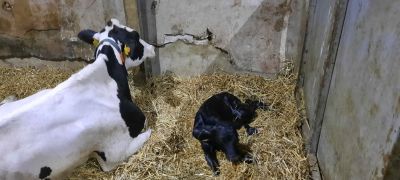
Posted By:
At Shepton Vets Farm, we are committed to staying informed about the latest developments and insights in animal healthcare. Recently, Anna delved into the concerning issue of uterine torsions in cattle. This condition can have significant implications for both the cows and the farmers who care for them. Anna sheds light on the incidence, potential causes, and management of uterine torsions, aiming to provide valuable knowledge to our farming community.
In the last month I have seen 5 uterine torsions which has prompted me to do some research. A recent study found that up to 22% of dystocia’s attended by vets were torsions, and the overall incidence of torsions in UK Holstein Friesians is 0.24% (Lyons et al., 2012). Twisting normally occurs during 1st stage or early 2nd stage labour when the pregnant horn rotates over the non-pregnant horn, most commonly in an anti-clockwise direction. The twist can vary between 90 degrees and 360 degrees. A definitive cause is unknown; however, it has been found that cows are at greater risk than heifers and twins are less of a risk (Aubry et al., 2008). At full term the uterus lies on the abdominal floor and is relatively unstable. When a cow lies down or stands up the uterus becomes suspended by the cervix in the abdominal cavity. It is thought that the combination of increased calf movements during 1st stage labour and a sudden slip, fall or knock by another cow could cause the unstable uterus to twist. Other potential influences are a small non-pregnant horn, decreased amounts of foetal fluid, reduced rumen volume and a large calf.
One of the greatest influences on success is whether the calf is alive or dead as it is easier to correct a torsion with a live calf. Quickly spotting cows with a uterine torsion will have a better chance of a successful outcome as a twisted uterus has its blood flow interrupted so it becomes fragile. Cows will generally be uncomfortable and shifting but will not always start pushing or show any membranes at the vulva. When examining the cow, you generally find that your arm is pushed to the left or right hand side and the calf can be hard to reach or upside down.
There are several methods to correct a torsion – manual untwisting, rolling the cow, detorsion rod and c-section. It is important to remember that after untwisting a torsion the cervix is often not fully dilated, therefore we need to be very careful with vaginal delivery of the calf. A study found that the next lactation culling rate of cows who had a torsion was 57%, with over half of these due to infertility (Lyons et al., 2013), however more research needs to be done into longer term outcomes.
- Vet Anna Hewison
As part of our ongoing commitment to animal health and the well-being of our farming partners, Shepton Vets Farm remains vigilant in exploring and sharing critical information like Anna's article on uterine torsions. We encourage farmers to stay proactive in recognising the signs and seeking prompt veterinary attention when needed. By working together and staying informed, we can continue to enhance the health and welfare of livestock and ensure the success of farming endeavors.
Whilst on my visits I have been having several discussions...
As our feline friends get older there are a few conditions...
Another winter discussion group season is now behind...
©2024 Shepton Veterinary Group Ltd., All rights reserved.
Privacy Policy • Terms & Conditions • Cookie Policy